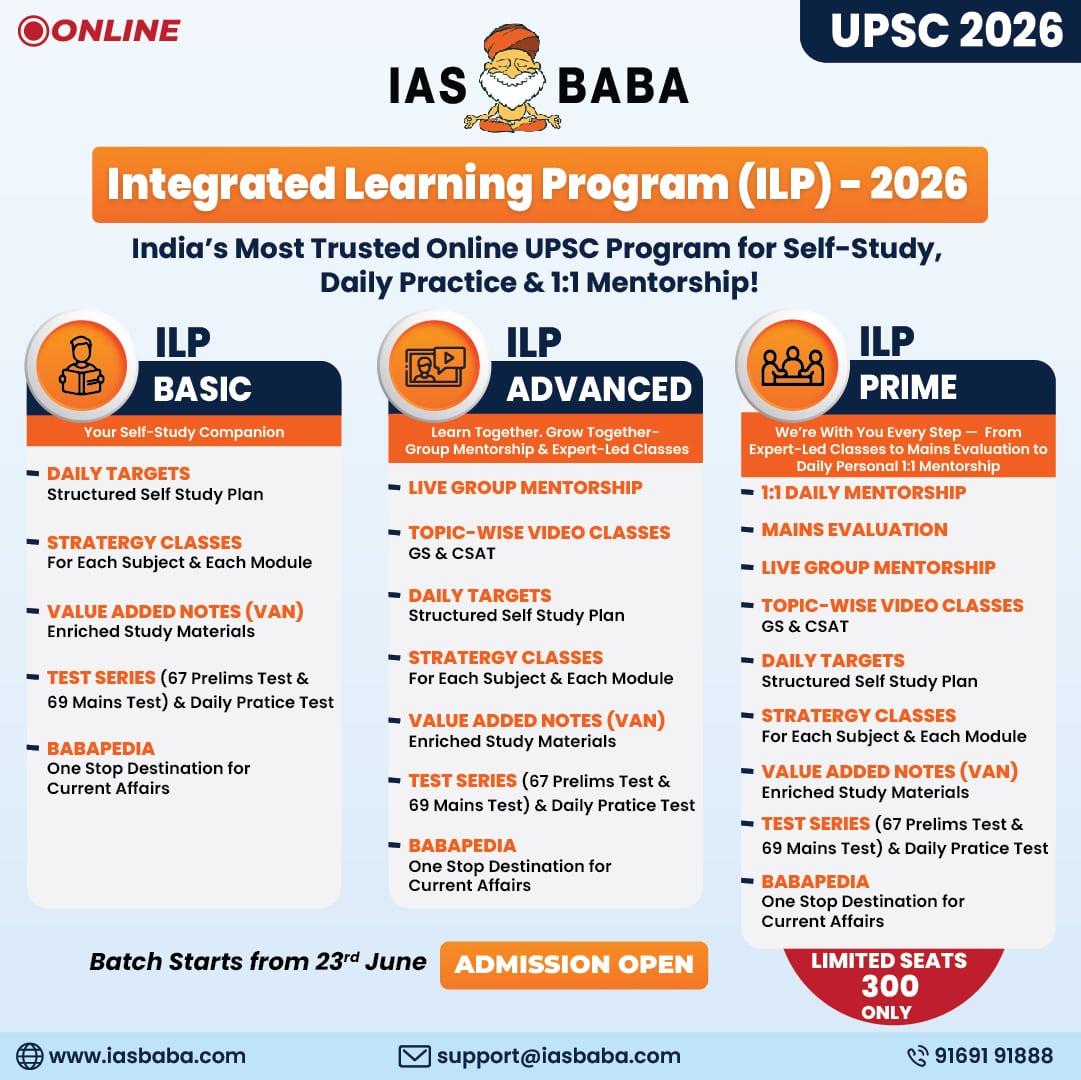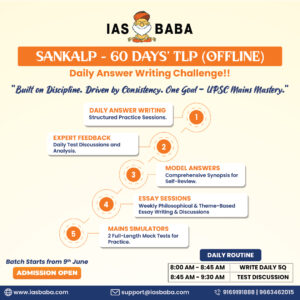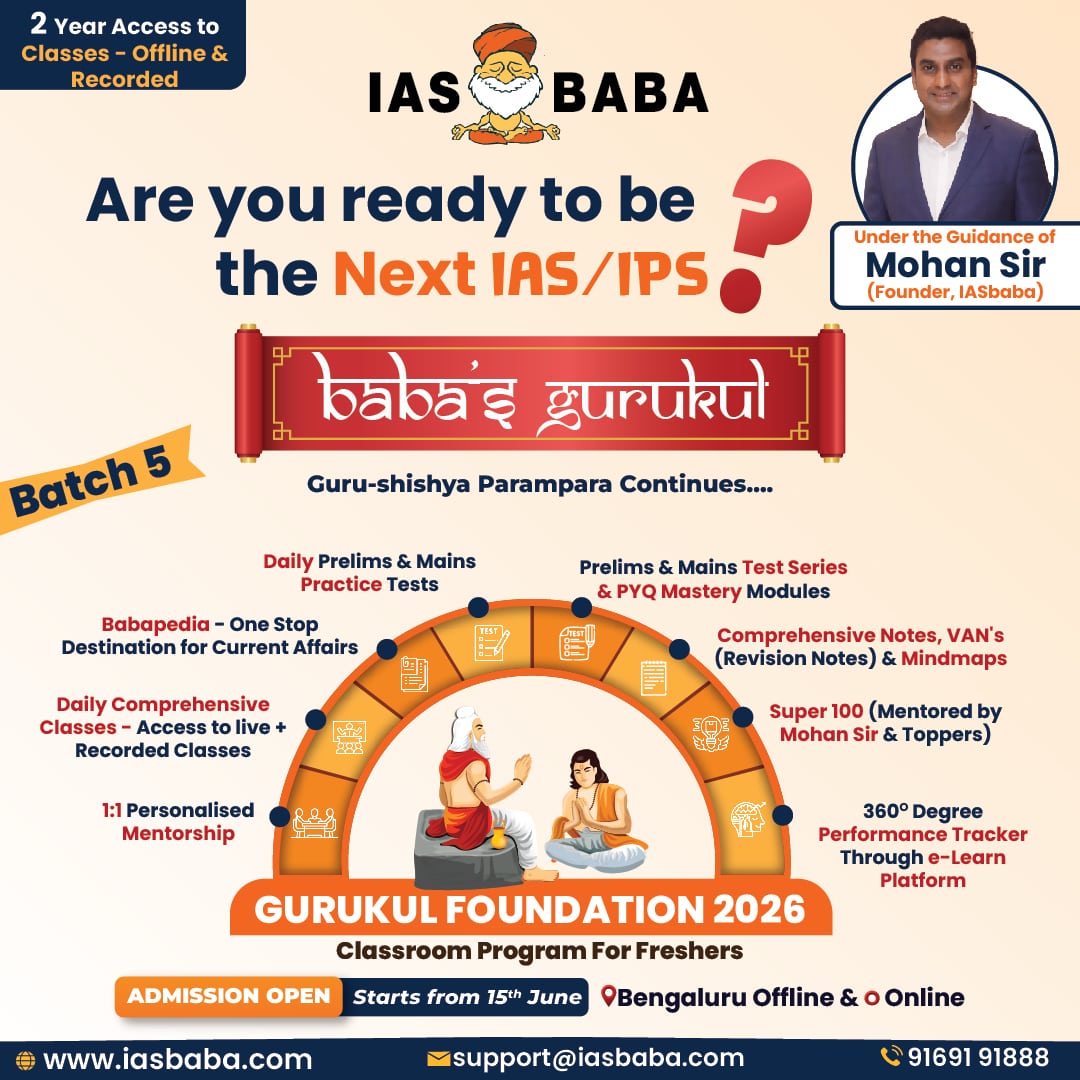IASbaba's Daily Current Affairs Analysis
Archives
(PRELIMS Focus)
Category: SCIENCE AND TECHNOLOGY
Context: Researchers have successfully sequenced the complete genome of a man who lived 4,500–4,800 years ago during Egypt’s Old Kingdom, marking a major breakthrough in ancient DNA research
Decoding the context:
The DNA was extracted from a well-preserved tooth found in a sealed clay vessel at Nuwayrat, south of Cairo, enabling exceptional preservation.
Key Highlights:
- Oldest and most complete genome from ancient Egypt, offering a rare genetic snapshot from the pyramid-building era.
- Ancestry analysis shows about 80% North African and 20% West Asian (Fertile Crescent) origins, confirming long-theorized population interactions.
- Skeletal evidence suggests the man led a labor-intensive life, possibly as a potter.
- This achievement overcomes decades of failed attempts due to DNA degradation in Egypt’s harsh climate.
The discovery not only supports archaeological theories of ancient connections between Egypt and the Middle East but also opens doors to studying broader genetic and cultural histories of early civilizations.
Learning Corner:
Genome Sequencing
Definition:
Genome sequencing is a laboratory method used to determine the entire DNA sequence of an organism’s genome. It reveals the order of nucleotides (adenine [A], thymine [T], cytosine [C], and guanine [G]), which form the genetic instructions that govern an organism’s structure and function.
Types of Genome Sequencing:
- Whole Genome Sequencing (WGS):
- Sequences the entire genome, including coding (exons) and non-coding regions (introns, regulatory sequences).
- Offers the most comprehensive genetic information.
- Whole Exome Sequencing (WES):
- Focuses only on the exome – the protein-coding regions (about 1–2% of the genome).
- More cost-effective, widely used in clinical diagnosis.
- Targeted Sequencing:
- Sequences specific genes or regions of interest.
Steps Involved in Genome Sequencing:
- Sample Collection: Tissue, blood, saliva, or (in ancient DNA) bone/teeth.
- DNA Extraction: DNA is isolated from the sample.
- Library Preparation: DNA is fragmented and tagged for identification.
- Sequencing: DNA fragments are read by sequencers (e.g., Illumina, Oxford Nanopore).
- Data Assembly: Fragments are aligned using bioinformatics tools to reconstruct the genome.
- Annotation: Identifying genes, mutations, and regulatory elements.
Applications:
| Field | Application |
|---|---|
| Medicine | Diagnosis of genetic disorders, cancer genomics, pharmacogenomics |
| Agriculture | Genetically improved crops, disease resistance |
| Forensics | Crime investigation, paternity testing |
| Evolutionary Biology | Study of ancient DNA, population migration |
| Microbiology | Pathogen identification, antibiotic resistance tracking |
Technologies Used:
- Sanger Sequencing: First-generation; accurate but slow and expensive.
- Next-Generation Sequencing (NGS): High-throughput, faster, cheaper (e.g., Illumina, Roche 454).
- Third-Generation Sequencing: Real-time, long-read technologies (e.g., PacBio, Oxford Nanopore).
Challenges in Ancient DNA Sequencing:
- Degradation: DNA breaks down over time, especially in hot climates like Egypt.
- Contamination: Modern human DNA can contaminate ancient samples.
- Low yield: Often, only a small amount of DNA is recoverable.
Source: THE HINDU
Category: ECONOMICS
Context: Gig workers in India are only partially represented in official labour data, with incomplete and inconsistent inclusion.
- Lack of Formal Recognition: Most gig workers are treated as independent contractors and are excluded from formal labour protections and regular employment statistics.
- Estimations, Not Enumeration: Projections from government bodies like NITI Aayog estimate up to 62 million gig workers by 2047, but these are based on surveys, not systematic inclusion.
- Limited Reach of e-Shram: While the e-Shram portal aims to register unorganized and gig workers, it has yet to achieve full coverage.
- Policy and Data Gaps: Existing frameworks are still evolving, and there’s a need for more robust mechanisms to include gig workers in labour statistics and social security systems.
Learning Corner:
Gig Workers in the India
Definition:
Gig workers are individuals who engage in flexible, temporary, or freelance jobs, often facilitated by digital platforms such as ride-sharing, food delivery, e-commerce logistics, and freelance services.
Key Features:
- Work is task-based and often on-demand.
- Employment is usually contractual with no formal employer-employee relationship.
- Includes platform workers (working via digital apps) and non-platform gig workers (offline freelance/short-term work).
Status in India:
- Growing Workforce:
- Estimated to reach 23.5 million by 2029–30 and 62 million by 2047.
- Driven by urbanization, youth population, and digital expansion.
- Lack of Formal Recognition:
- Gig workers are largely excluded from traditional labour laws, social security, and formal data sets.
- Considered “independent contractors,” they often lack protections like minimum wage, health insurance, or job security.
- Policy Measures:
- e-Shram Portal: Launched to register unorganized and gig workers, though coverage is still limited.
- Code on Social Security, 2020: Aims to extend social protection to platform and gig workers.
- Challenges:
- Data and regulatory gaps, inconsistent income, lack of job security.
- Absence of grievance redressal and collective bargaining mechanisms.
Source: THE HINDU
Category: INTERNATIONAL
Context : Indian universities have shown notable progress in the QS World University Rankings 2025, both globally and within Asia.
- IIT Delhi is now India’s top-ranked institution, placed 44th in Asia, followed by IIT Bombay at 48th.
- A total of seven Indian institutions features in Asia’s top 100:
- IIT Delhi (44), IIT Bombay (48), IIT Madras (56), IIT Kharagpur (60), IISc (62), IIT Kanpur (67), University of Delhi (81).
- UPES Dehradun made the biggest leap, jumping 70 spots to 148th.
- In the QS Sustainability Rankings 2025, IIT Delhi ranks 171st globally, leading among Indian institutions, followed by IIT Kharagpur (202) and IIT Bombay (234).
Learning Corner:
QS World University Rankings
QS World University Rankings are annual rankings published by Quacquarelli Symonds (QS), a UK-based higher education analytics firm. They are among the most widely referenced global university rankings.
Key Features:
- First Published: 2004
- Coverage: Over 1,500 universities worldwide
- Categories: Global, regional (Asia, Europe, etc.), subject-specific, and sustainability rankings
Main Indicators Used:
- Academic Reputation (40%)
- Employer Reputation (10%)
- Faculty-Student Ratio (20%)
- Citations per Faculty (20%)
- International Faculty Ratio (5%)
- International Student Ratio (5%)
Note: Weightage may vary for subject or region-specific rankings.
Significance:
- Helps students compare universities globally.
- Influences international collaborations, funding, and student mobility.
- Encourages institutions to improve academic and research performance.
Recent Addition:
- QS Sustainability Rankings assess universities on environmental and social impact.
Source : THE HINDU
Category: INTERNATIONAL
Context: The 14th Dalai Lama announced on Wednesday (July 2) “that the institution of the Dalai Lama will continue” and that the Gaden Phodrang Trust shall be the “sole authority to recognize the future reincarnation”
Gaden Phodrang Trust – A Brief Overview
The Gaden Phodrang Trust is a non-profit charitable organization established in 2011 by the 14th Dalai Lama in Dharamshala, India. It is entrusted with upholding his religious, cultural, and humanitarian initiatives and, most importantly, overseeing the recognition of his reincarnation.
Key Points:
- Sole Authority: The Trust is the only authorized body to recognize the next Dalai Lama, as declared by the 14th Dalai Lama. This rejects any external interference, particularly from China.
- Tradition-Based Recognition: The Trust will follow Tibetan Buddhist traditions, consulting heads of Buddhist schools and spiritual oracles associated with the Dalai Lama lineage.
- Historical Link: The term “Gaden Phodrang” originally referred to the Dalai Lama’s residence at Drepung Monastery in Lhasa, later symbolizing the Dalai Lama institution.
- Inclusive Vision: The Dalai Lama stated the next reincarnation could be of any gender, reaffirming continuity of the spiritual role beyond political boundaries.
- Political Significance: The move is seen as an effort to protect the independence and authenticity of the Dalai Lama’s succession against Chinese claims to control the process.
Learning Corner:
Institution of the Dalai Lama
The Institution of the Dalai Lama is the spiritual and political leadership system of the Tibetan people, rooted in Tibetan Buddhism, particularly the Gelug school. The Dalai Lama is regarded as the reincarnation (tulku) of Avalokiteshvara, the Bodhisattva of Compassion.
Key Features:
- Spiritual Leader: The Dalai Lama serves as the highest spiritual authority in Tibetan Buddhism, guiding followers in religious doctrine and moral values.
- Political Legacy: From the 17th century until 1959, the Dalai Lamas were also temporal rulers of Tibet, combining religious and political authority.
- Reincarnation System: Each Dalai Lama is believed to be a reincarnation of his predecessor, discovered through spiritual signs, visions, and traditional tests conducted by senior lamas and oracles.
- 14th Dalai Lama: Tenzin Gyatso is the current (14th) Dalai Lama. In 1959, after the Chinese occupation of Tibet, he fled to India and set up the Tibetan government-in-exile in Dharamshala.
Modern Context:
- The 14th Dalai Lama relinquished political authority in 2011 to a democratically elected leader, retaining only his spiritual role.
- He established the Gaden Phodrang Trust to oversee his legacy and the future recognition of his reincarnation, emphasizing that only Tibetan Buddhists—not governments—have the authority to decide.
Source: THE INDIAN EXPRESS
Category: SCIENCE AND TECHNOLOGY
Context: Recent moves in the US and UK to block AI web crawlers have triggered growing calls in India for fair revenue sharing and legal safeguards to protect digital content creators.
Key Developments:
- Cloudflare’s New Policy (July 2025): AI bots are blocked by default unless publishers grant permission or receive compensation, giving them control over how their content is used for AI training or inference.
- Publisher Action: Leading media outlets in the US and UK now restrict AI crawlers to protect their journalism and push for fair monetization.
- Impact on Publishers: AI-generated answers have drastically reduced search traffic to original websites—up to 90% of users no longer click through, cutting into publishers’ revenue while AI firms profit.
- Indian Response: Indian news publishers are now demanding:
- Fair revenue sharing from AI companies using their content.
- Stronger legal protections against unauthorized scraping.
- Measures to safeguard the open web and independent journalism.
Learning Corner:
Web Crawlers
Web crawlers, also known as spiders or bots, are automated software programs designed to browse and index content across websites on the internet.
Key Functions:
- Content Indexing: Used by search engines (like Google, Bing) to collect and organize website content for inclusion in search results.
- Data Collection: Extract data from web pages for analytics, research, or AI training.
Types:
- Search Engine Crawlers: For indexing websites (e.g., Googlebot).
- AI Crawlers: Used by AI companies to collect data for model training and inference.
- Malicious Crawlers: Used for scraping sensitive or copyrighted content without permission.
Working Mechanism:
- Start with a list of URLs.
- Visit web pages, read content, and follow hyperlinks.
- Store and organize data for use in search engines or AI systems.
Concerns and Challenges:
- Unauthorized Scraping: Web crawlers can collect copyrighted or personal data without consent.
- Bandwidth Strain: Heavy crawling can overload servers.
- Legal/Ethical Issues: Especially relevant in cases where content is used for AI training without compensation.
Control Mechanisms:
- robots.txt: A file website uses to tell crawlers which pages to access or avoid.
- Firewall Settings & Blocking Tools: To restrict harmful or unauthorized crawlers.
Source: THE INDIAN EXPRESS
(MAINS Focus)
Introduction (Context)
Artificial Intelligence (AI) is rapidly transforming economies, societies, and governance worldwide. India, as the world’s largest democracy and an emerging technology hub, has declared its ambition to become a global leader in AI governance. However, this aspiration faces significant risks due to the absence of a transparent, democratically anchored national AI strategy.
Opportunities for India in AI
- Economic Transformation: AI has the potential to significantly boost productivity, efficiency, and innovation across sectors like healthcare, education, agriculture, and manufacturing.
- Job Creation and New Skill Development: With strategic planning, AI can generate new job opportunities, particularly in AI development, data science, and allied industries.
- Global Leadership Potential: India can position itself as a voice for the Global South in shaping inclusive and ethical global AI norms.
- Public Service Delivery: AI can enhance governance through improved service delivery, predictive policymaking, and efficient public resource management.
- Data-Driven Innovation: With vast public datasets, India can drive indigenous innovation, provided governance mechanisms ensure data security and equitable access.
Challenges in India’s AI Journey
- Absence of a Comprehensive National AI Strategy: Current initiatives like the IndiaAI Mission lack strategic clarity and democratic oversight.
- Governance Gaps: Without clear regulatory frameworks, risks such as bias, discrimination, surveillance, and loss of accountability may arise.
- Workforce Displacement: Automation threatens jobs, especially in sectors like IT, where firms like TCS, Infosys, and Wipro are already shedding roles.
- Technological Dependence: Lack of indigenous AI capabilities increases vulnerability to global tech dependencies and geopolitical risks.
- Socio-Economic Inequalities: Without inclusive planning, AI adoption may deepen digital divides and marginalisation.
- Energy & Infrastructure Demands: AI is highly energy-intensive, exacerbating challenges related to power and water resources.
Way Forward
- Formulate a National AI Strategy: Develop a democratically debated, Cabinet-endorsed AI policy to guide ethical and inclusive AI adoption.
- Establish a Parliamentary Standing Committee on AI & Emerging Technologies to ensure legislative oversight and public accountability.
- Inclusive Stakeholder Engagement: Involve industry, academia, civil society, workforce representatives, and policymakers to build consensus.
- Regulatory & Ethical Frameworks: Prioritise safeguards against bias, discrimination, data misuse, and monopolistic practices.
- Reskilling & Workforce Transition: Invest in large-scale skilling programs to prepare citizens for AI-driven economic shifts.
- Leverage India’s Global Position: Actively participate in shaping global AI governance through platforms like the Global Partnership on AI.
- Focus on Indigenous Innovation: Strengthen domestic AI research, reduce technological dependencies, and ensure data sovereignty.
Conclusion
AI presents India with transformative opportunities, but without a well-thought-out, transparent, and democratically anchored national strategy, these benefits may be overshadowed by risks. A coherent, inclusive, and forward-looking approach is essential to ensure AI serves India’s socio-economic goals while safeguarding democratic values and national interests.
Mains practice question:
“India’s ambition to be a global leader in Artificial Intelligence requires a democratically anchored national strategy.” Discuss the need for such a strategy and suggest measures to ensure ethical and inclusive AI governance in India. (250 words)
Introduction (Context)
Palliative care is a specialised healthcare approach that focuses on improving the quality of life for individuals with life-limiting illnesses by relieving pain, suffering, and addressing psychological and social distress. In India, inadequate access to palliative care undermines the Right to Life with Dignity, guaranteed under Article 21 of the Constitution.
Growing Need for Palliative Care in India
- India’s elderly population is projected to reach 192 million by 2031 and 340 million by 2050 (UNFPA, 2023).
- Non-communicable diseases (NCDs) account for 65% of all deaths, with rising cases of cancer, diabetes, and chronic respiratory illnesses (ICMR, 2022).
- Changing family structures due to globalisation and urbanisation have weakened traditional caregiving mechanisms, increasing demand for formal palliative care.
Challenges in Accessing Palliative Care
- Shortage of Trained Professionals
- Inadequate inclusion of palliative care in medical education.
- Inadequate Infrastructure & Funding
- Limited government investment and accessibility, especially in rural areas.
- Low Public Awareness & Social Stigma
- Misconceptions linking palliative care only to end-of-life support.
- Policy-Implementation Gaps
- Despite recognition in National Health Policy, 2017, implementation remains weak.
Measures to Strengthen Palliative Care
- Integrate palliative care into primary healthcare and medical training.
- Expand community-based models like the Kerala Model, which provides 70% of India’s palliative care services.
- Launch awareness campaigns to reduce stigma.
- Encourage public-private partnerships for service expansion.
- Adapt global best practices to suit India’s socio-economic context.
Conclusion
With a rapidly ageing population and rising NCD burden, ensuring universal access to palliative care is essential to uphold the constitutional Right to Live with Dignity and build a humane, inclusive healthcare system.
Mains practice question:
In the context of India’s ageing population and rising burden of non-communicable diseases, discuss the significance of palliative care. Highlight the challenges and suggest measures to uphold the Right to Live with Dignity. (250 words)
Daily Practice MCQs
Today’s – Daily Practice MCQs’ will be updated in our “Daily Current Affairs Quiz” section on our website
Please click on the below link











